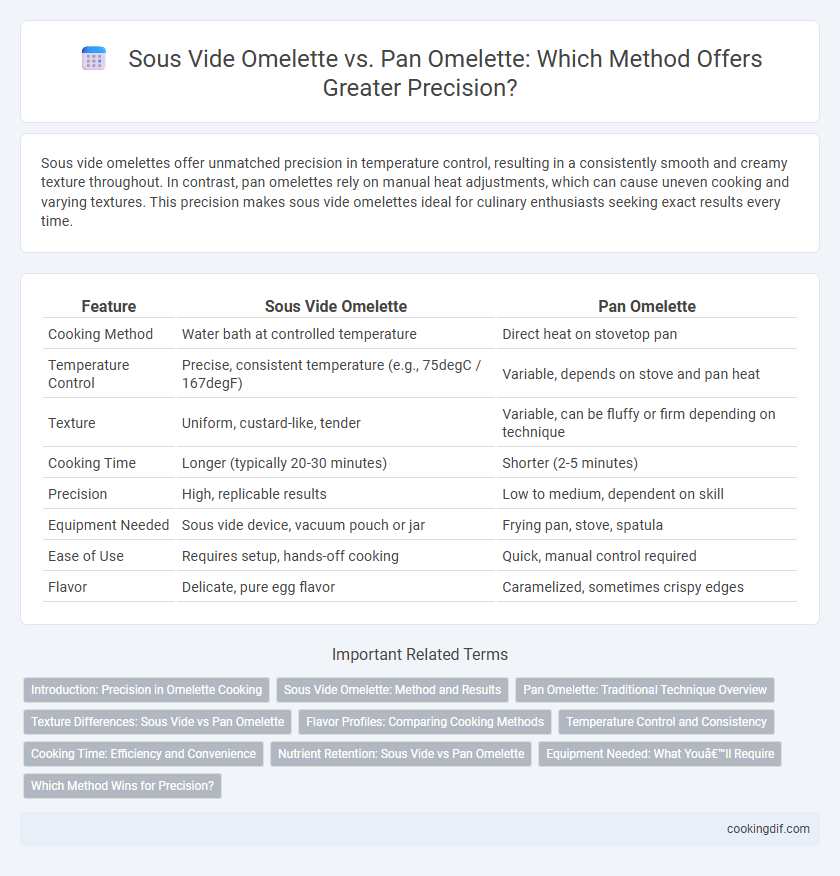Sous vide omelettes offer unmatched precision in temperature control, resulting in a consistently smooth and creamy texture throughout. In contrast, pan omelettes rely on manual heat adjustments, which can cause uneven cooking and varying textures. This precision makes sous vide omelettes ideal for culinary enthusiasts seeking exact results every time.
Table of Comparison
| Feature | Sous Vide Omelette | Pan Omelette |
|---|---|---|
| Cooking Method | Water bath at controlled temperature | Direct heat on stovetop pan |
| Temperature Control | Precise, consistent temperature (e.g., 75degC / 167degF) | Variable, depends on stove and pan heat |
| Texture | Uniform, custard-like, tender | Variable, can be fluffy or firm depending on technique |
| Cooking Time | Longer (typically 20-30 minutes) | Shorter (2-5 minutes) |
| Precision | High, replicable results | Low to medium, dependent on skill |
| Equipment Needed | Sous vide device, vacuum pouch or jar | Frying pan, stove, spatula |
| Ease of Use | Requires setup, hands-off cooking | Quick, manual control required |
| Flavor | Delicate, pure egg flavor | Caramelized, sometimes crispy edges |
Introduction: Precision in Omelette Cooking
Sous vide omelettes offer unparalleled precision by cooking eggs at a controlled, consistent temperature, ensuring even texture and avoiding overcooking. Traditional pan omelettes rely on experienced heat management, often resulting in variable texture and doneness across the surface. Precise temperature control in sous vide cooking enhances flavor development and yields a consistently creamy, smooth omelette every time.
Sous Vide Omelette: Method and Results
Sous vide omelettes utilize precise temperature control by cooking eggs in a water bath at a consistent temperature, typically around 75degC (167degF), ensuring even coagulation without overcooking. This method produces a custard-like texture with uniform doneness throughout, eliminating the risk of browning or rubbery edges common in pan-cooked omelettes. The controlled environment results in a tender, moist omelette with enhanced flavor retention and superior texture compared to traditional pan cooking.
Pan Omelette: Traditional Technique Overview
Pan omelettes offer precise control over heat and cooking time, allowing chefs to adjust texture and doneness intuitively during the cooking process. The traditional technique relies on direct contact with the pan's surface, resulting in a rich, caramelized flavor and a tender, fluffy interior. Mastery of temperature and timing in pan omelette preparation ensures a perfectly cooked dish tailored to individual preferences.
Texture Differences: Sous Vide vs Pan Omelette
Sous vide omelettes offer unparalleled texture precision, yielding a consistently creamy and custard-like interior with no risk of overcooking due to controlled temperature immersion. In contrast, pan omelettes often present variable textures, ranging from slightly browned and firmer edges to a softer, sometimes uneven center caused by direct heat exposure. The sous vide method ensures a smooth, uniform texture throughout, while pan cooking emphasizes a more traditional, slightly crispy exterior coupled with a tender inside.
Flavor Profiles: Comparing Cooking Methods
Sous vide omelettes offer unparalleled precision by maintaining a consistent temperature that enhances the custard-like texture and preserves delicate flavors, allowing the eggs to cook evenly without overcooking. Pan omelettes develop a more complex flavor profile through Maillard browning and slight caramelization, creating a richer, slightly toasted taste that contrasts with the gentle subtleties of sous vide cooking. Flavor intensity in pan omelettes varies with cooking time and heat, while sous vide cooking delivers a uniform and tender result, emphasizing freshness and egg flavor clarity.
Temperature Control and Consistency
Sous vide omelettes offer unparalleled temperature control, maintaining a precise water bath temperature to cook eggs evenly without overcooking or browning, resulting in a consistently tender texture. Pan omelettes depend heavily on stove heat settings and user technique, leading to variable temperature zones and occasional hot spots that can cause uneven cooking or burnt edges. This makes sous vide the superior method for achieving consistent doneness and texture in every omelette.
Cooking Time: Efficiency and Convenience
Sous vide omelettes offer precise temperature control, ensuring consistent texture by cooking at a steady low heat for 15 to 20 minutes, while pan omelettes require constant attention and quicker cooking times of 3 to 5 minutes. The sous vide method enhances efficiency by allowing multitasking without risk of overcooking, whereas pan cooking demands active monitoring to prevent burning or uneven doneness. Sous vide offers convenience through hands-off preparation and repeatable results, ideal for exact culinary standards and time management.
Nutrient Retention: Sous Vide vs Pan Omelette
Sous vide omelettes retain more nutrients due to the controlled low-temperature cooking, preventing the degradation of heat-sensitive vitamins like B-complex and C. Pan omelettes, cooked at higher direct heat, often experience greater nutrient loss and uneven cooking. The precise temperature regulation in sous vide ensures optimal protein texture while maximizing nutrient preservation compared to traditional pan methods.
Equipment Needed: What You’ll Require
Sous vide omelettes require specialized equipment, including an immersion circulator and vacuum-sealed bags to maintain precise temperature control, ensuring consistent texture and doneness. Pan omelettes need basic kitchen tools such as a non-stick skillet, spatula, and stovetop, offering more accessible and straightforward preparation. The choice of equipment directly impacts the precision and repeatability of the omelette cooking process.
Which Method Wins for Precision?
Sous vide omelettes offer unmatched precision by cooking eggs at a consistent, controlled temperature, resulting in a perfectly tender and evenly cooked texture. In contrast, pan omelettes rely heavily on the cook's skill to regulate heat and timing, often leading to uneven cooking or slight overcooking. For culinary professionals and enthusiasts seeking exact texture and doneness, sous vide omelette preparation clearly wins in terms of precision.
Sous Vide Omelette vs Pan Omelette for precision Infographic

 cookingdif.com
cookingdif.com